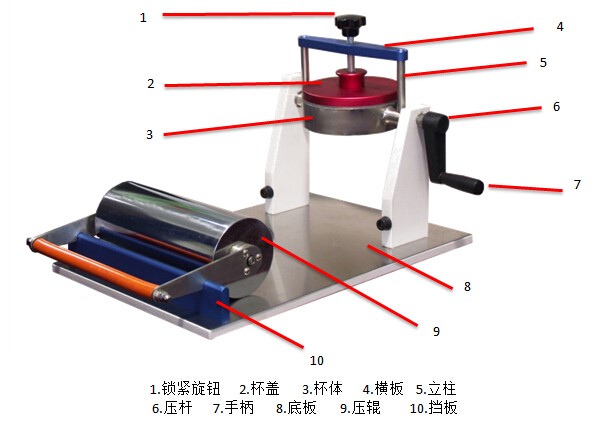Source: Link Testing Instruments co.,ltd

Test
4.2.1 Use a balance with a resolution of not less than 0.01g to weigh the mass g1 of the cut circular sample.
4.2.2 Unscrew the locking knob counterclockwise, remove the lid, and pour 100ml±5ml of distilled or deionized water into the cup at a temperature of 20°C±1°C.
4.2.3 Put the sample on the mouth of the cup and cover the lid, tighten the locking knob clockwise to compress the lid, lift the knurled handle with the left hand, and shake the handle with the right hand to make the mouth of the cup downward and put down the knurled handle. Position the cap and start the stopwatch at the same time to start timing.
4.2.4 According to the selected test time, in the table below
Within the recommended time to remove the remaining water, lift the knurled cap, turn the mouth of the cup upwards and lock it, quickly loosen the locking knob to loosen the lid, remove the sample, and remove the sample at the moment when the water absorption is complete. The side of the sample in contact with water is placed downward on the pre-prepared absorbent filter paper on the bottom plate of the instrument, and then another absorbent filter paper is covered, and the pressure roller is used to roll back and forth once within 4 seconds without any other pressure to remove the remaining surface of the sample. of water to blot dry. Fold the side of the sample that is in contact with water inward and quickly weigh the mass g2 of the sample after absorbing water.
The total test time recommended by international standards for removing residual water and absorbing water
| Recommended time s | Mark | time to remove remaining water s | Time to complete water absorption s |
| 30 | cobb30 | 20±1 | 30±1 |
| 60 | cobb60 | 45±1 | 60±2 |
| 120 | cobb120 | 105±2 | 120±2 |
| 300 | cobb300 | 285±2 | 300±2 |
| 1800 | cobb1800 | 1755~1815 | after removing the remaining water 15±2 |
4.2.5 Calculating the water absorption value according to the difference between the two weighed samples:
C=(g2-g1)×100 (g/m2)
Note: Generally, the test is required to be a group of positive and negative, each group is 5 times, and the average value is calculated
4.2.6 Wipe off the water on the edge of the cup mouth and the surface of the rubber pad of the cup lid, make up the amount of water in the cup with the top surface of the water level screw as a reference, and carry out the next test according to the above steps.
4.3 Notes
4.3.1 After each group of samples is tested, the water should be replaced with new water.
4.3.2 The test water shall use distilled water or deionized water.
4.3.3 The quantitative regulation of absorbent filter paper is 200~250g/m2.
Note: According to Article 4.3.1 of the test method standard GB1540:
"When the weight of a single layer of water-absorbing filter paper is less than 200-250g/m2, multi-layer stacking can be used to meet the requirements."
4.3.4 When testing corrugated cardboard, during the rolling process of the press roller, the axis of the press roller should be parallel to the direction of corrugation.
4.3.5 When using rollers for rolling, no external force in the vertical direction shall be applied to the rollers.
4.3.6 Each test piece can only be tested once and cannot be reused.
5 Maintance
5.1 Keep the instrument clean and dry daily.
5.2 During use, prevent collision damage between the instrument and the surface of the pressure roller.
5.3 All rotating or sliding parts should be lubricated from time to time.
5.4 Be careful not to damage the surface of the cup mouth and the cup cover, so as not to affect the seal.
5.5 Keep the inside of the cup clean. After the test, pour out all the water and dry it to prevent corrosion.
For more details please visit www.linktesting.org